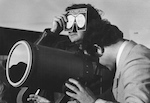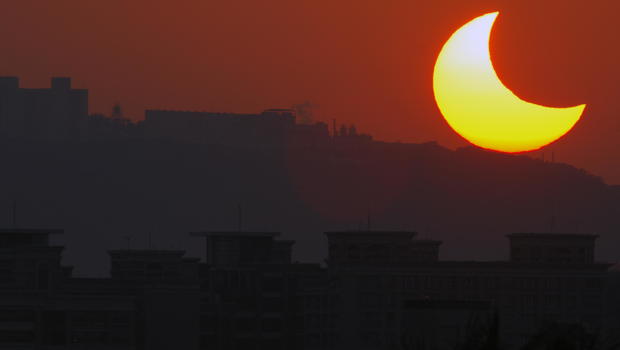While millions will watch the August 21st total solar eclipse from the ground, the International Space Station crew will have an amazing view high overhead.

The umbra of the Moon as seen from the International Space Station during the March 29, 2006 total solar eclipse.
NASA
Less than three weeks lie between us and the first total solar eclipse cross the contiguous United States in 38 years. If you're like us, you've already got a plan (and a backup plan) for the main event on Monday, August 21st. (Observers in eastern Europe, Africa, and Asia won't miss out completely: they'll see the pre-show event, a partial lunar eclipse on Monday, August 7/8th.)

The path of the August 21st, 2017 total solar eclipse across the United States.
Michael Zeiler / greatamericaneclipse.com
Humans in space will watch as well, as the International Space Station zips 250 miles above Earth's surface, orbiting the planet once every 93 minutes.
"Our flight team is tracking opportunities for astronauts onboard the station to photograph both the eclipse and the Moon's shadow on the planet," says Daniel Huot (NASA Johnson Space Center) "They have solar filters for photographing the eclipse itself and will have one opportunity to see the Moon's shadow.
Astronauts have witnessed solar eclipses from space before, starting with the partial solar eclipse caught by Gemini 12 on November 12, 1966. More recently, NASA astronaut (and amateur astronomer) Don Pettit captured a total solar eclipse over the Pacific in May 2012, and European Space Agency astronaut Samantha Chistoforetti nabbed the partial phase of the March 20, 2015, total solar eclipse over the Faroe Islands. NASA astronaut Randy Bresnik recently arrived aboard the ISS and is, like Pettit, also a skilled photographer who is up to the challenge.
Thus far, though, no one on the ISS has managed to “thread the needle,” with a view passing through the narrow umbra of a total solar eclipse. Such a view would, of course, be fleeting, as the ISS moves 17,000 mph from southwest to the northeast, while the umbra of the Moon crosses the U.S. on August 21st from the northwest to the southeast at speeds up to 1,400 mph near mid-eclipse.

The first pass of the ISS during the eclipse at 16:41 UT (note: the inset shows the eclipsed Sun; the graphics are from the Sun's perspective.
NASA/JSC
NASA currently plans on three opportunities to spy the eclipse during partial phases. The first pass will occur at 16:41 Universal Time (UT), just prior to the touchdown of the umbra over the Pacific at 16:49 UT, with partial phases of the eclipse already underway for western North America. ISS astronauts will see a 37% eclipsed Sun on this first pass.

The second pass of the ISS during the eclipse at 18:24 UT.
NASA/JSC
On pass two at 18:24 UT, things could get interesting. Although the ISS will not pass through the umbra, it should be visible from the station as it races races across Illinois, Kentucky, and Tennessee near maximum totality. Mir cosmonauts managed to catch this kind of view during the total solar eclipse crossing Europe one saros cycle ago, on August 11, 1999.

The third pass of the ISS during the eclipse at 18:16 UT.
NASA/JSC
Finally, the ISS crew will say goodbye to the eclipse as it departs Earth over the mid-Atlantic. This could provide an amazing opportunity to catch the “horns” of the eclipsed Sun setting behind the limb of the Earth, as the Sun fattens from 85% coverage to 27%.
At present, these times are approximate. The ISS is scheduled to perform an orbital boost on August 9th, and there's always the possibly of an unscheduled Debris Avoidance Maneuver (DAM) over the next few weeks.
“Flight controllers are still finalizing the details and identifying windows that might give a view of the Sun during the eclipse,” says Huot. ISS crew will be shooting the Sun out the cupola window using DSLRs and filter-covered lenses.
Catching a Transit of the ISS on Eclipse Day

GOES-10 sees the shadow of the Moon cross the Earth on February 26, 1998.
NASA / GSFC / NOAA
As the ISS passes overhead, there's also a good chance to nab the station transiting the partially eclipsed Sun during those first two passes. Renowned astrophotographer Thierry Legault captured the ISS crossing a partially eclipsed Sun from Oman on January 4, 2011.
This kind of shot takes some planning, as you have to be right along the precise path of the transit at the right time. You'll need the ability to shoot at a high frame rate or video with a properly filtered camera rig equipped with a zoom of at least 400 mm or better, to produce a good-sized disk of the Sun. ISS transits of the Sun or Moon are quick, often lasting less than 1 second. I like to have an accurate audible time hack via WWV Radio on shortwave AM playing in the background as well to know when to begin shooting.
CalSky is your best bet for precise transit predictions leading up to the eclipse. Keep in mind, the orbit of the ISS changes over time due to periodic boosts and atmospheric drag, so check those pass predictions within 48 hours of eclipse day.
Other missions may see the eclipse from space as well. The joint JAXA/NASA mission Hinode observes the Sun from a low-altitude orbit, as does the European Space Agency's Proba 2. Full-disk Earth-observing satellites such as DSCOVR, Himawari 8 and GOES 15 also typically nab the umbra of the Moon sliding across the face of Earth as well.
NASA will also employ a pair of converted WB-57 bombers to chase totality's shadow. In addition to observing the solar corona, the aircraft will take infrared images of Mercury pre- and post-totality, as well as sweep the skies near the eclipsed Sun for tiny Vulcanoid asteroids.
The big advantage to taking to the air and space, of course, is not having to worry about eclipse-day weather. We should start seeing the first long-range forecasts for those of us on the ground late next week, and we'll be watching Clear Sky Charts, Skippy Sky and NOAA models the weekend prior.
Remember, you don't need clear skies, just a clear view of the Sun during those precious minutes of totality!
Quelle: Sky&Telescope
---
Update: 8.08.2017
.
The Great American Eclipse Is 2 Weeks Away. Are You Ready?
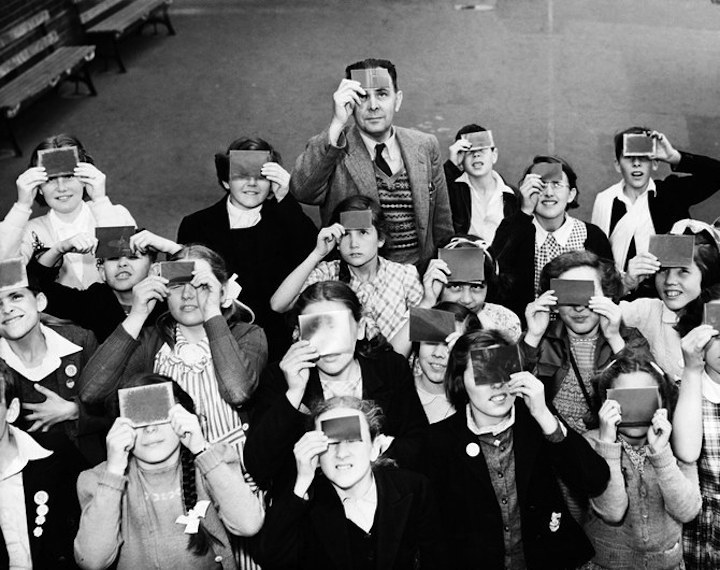
The Aug. 21 total solar eclipse will sweep across the continental U.S., beginning in Oregon and ending in South Carolina. The last time an eclipse touched both American coasts was in 1918. Eclipse enthusiasts say this phenomenon is one of the most spectacular sights in nature. As a sort of celestial preview, the moon will pass through part of Earth's shadow in a partial lunar eclipse today (Aug. 7).
Skywatchers throughout the U.S. will be able to witness a partial solar eclipse on Aug. 21, when the moon covers less than 100 percent of the sun's disk. But only skywatchers inside the path of totality will see the incredible phenomenon of a total solar eclipse. Wherever you will be, it's a good idea to have solar viewing glasses on hand. Or, you can build your own pinhole camera to watch the moon's progress across the sun.
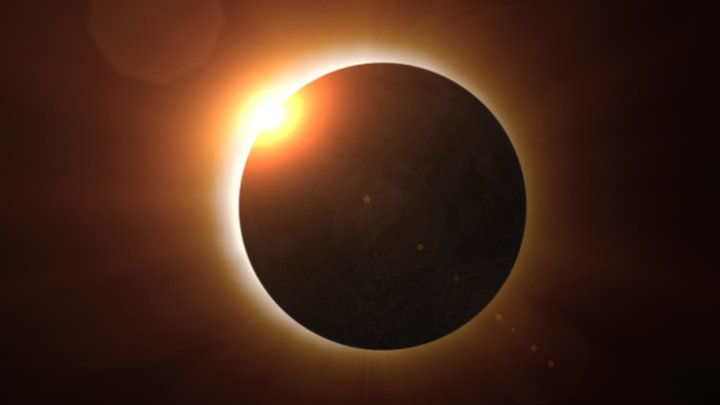
You can use this interactive eclipse map to find out exactly where totality will be visible, as well as when totality will occur at different locations inside the path. Totality will last for less than 3 minutes depending on how close you are locatedto the center line, so make sure you are looking skyward at the right time!
If you plan on traveling to see totality, be aware that experts are expecting nightmarish traffic conditions. Plan for extra time to reach your destination. Many cities and towns along the path of totality are planning eclipse-related events that could cause additional traffic delays. Research your destination ahead of time to find out where to park and where to observe the eclipse.
With two-thirds of Americans living within a day's drive of the eclipse, some eclipse experts have anticipated that the weekend leading up to the August eclipse will see more travelers in the air, on the rails and on the road than any other time in 2017. That could present serious problems for those viewing the eclipse, even if they don't have to travel to see it. And people who live inside the eclipse path but choose to miss the once-in-a-lifetime event will not be spared.
"There will hopefully be less bloodshed, but zombies don't need regular food, or sleep, or toilets," Speck said. Eclipse spectators, on the other hand, need all those things.
Once-in-a-lifetime sight
A total solar eclipse occurs when the moon completely blocks the disk of the sun. While partial solar eclipses are common, with two to five occurring around the world each year, a total solar eclipse happens somewhere on Earth only about once every 18 months. The last total solar eclipse touched the continental United States in 1979, and the last to cross from ocean to ocean occurred in 1918.
The August eclipse will pass through 14 states and five state capitals. During the partial phase, as the moon takes a bite out of the sun, observers should use eclipse glasses or a pinhole camera to watch the eclipse, as should those only able to observe a partial eclipse.
Totality (the period in which the disk of the sun is completely hidden) will last less than 3 minutes, but can be a truly stunning sight. After the body of the sun is completely blocked and the vicinity is cloaked in darkness, observers can remove their glasses. The dancing tendrils of the sun's outer atmosphere, usually outshone by its brighter body, will become visible.
REMEMBER: Looking directly at the sun, even when it is partially covered by the moon, can cause serious eye damage or blindness. NEVER look at a partial solar eclipse without proper eye protection. See our complete viewing guide to find out how to view the eclipse safely.
As the final days wind down to the eclipse, make sure you have your eclipse glasses. Sunglasses — even multiple pairs — are insufficient for viewing an eclipse. A pinhole viewer can also allow you to safely watch the event without damaging your vision.


"Many cities along the path of totality have been preparing for this and [are setting] up multiple observing sites with safe solar viewing gear," Paul Sutter, a researcher and outreach coordinator at Ohio State University (and a Space.com contributor), said in an email.
Don't despair if you can't make it to one of these sites.
"Just go somewhere else," Sutter said. "A park, a parking lot, your back yard. You just need a good view of the sky and you're golden."
While the eclipse itself is brief, it may be worth coming early for the science talks that may occur.
"If you can, I highly recommend making a whole day out of it," Sutter said.

Zombie apocalypse
While 12 million people live within the path of totality, another 200 million people live within a day's drive of the eclipse. How many intend to travel to see the eclipse remains unknown. Michael Zeiler, an eclipse cartographer, conservatively estimates that between 1.85 million and 7.4 million people may journey experience the total eclipse.
If you are planning to travel for the eclipse, you've hopefully already made hotel reservations. Most — if not all — of the hotel rooms along the eclipse path are filled, as serious eclipse hunters have been planning for the event for well over a year. Alternative housing arrangements, such as campsites or rooms in private homes, may still be available. But even if you are planning to stay with a friend, expect problems.
That's because the population of cities along the eclipse path is expected to double in the days around the event, Speck said, a rise that could trigger a host of unexpected problems.
"No town or city has the capacity to house so many visitors in hotels; nowhere has enough restaurants to feed such a huge crowd," she said. "Are there enough bathrooms? Probably not."
Folks who live along the path — whether they plan to see the eclipse or not — should prepare much like they would before a major storm. Speck advises folks to stock their fridges and fill up their cars with gas, "because the chances are that neither supermarkets nor gas stations will be sufficiently supplied." That means if you're crashing with friends or family, don't bank on eating out or parking downtown. [How to Survive the Total Solar Eclipse of 2017]
Speck proposed that communities can prepare by having gas stations fill up extra tanks and supermarkets keep refrigerated trucks on hand for extra storage.
"Maybe restaurants could do special reduced menus to get the crowd thru quicker, maybe they could hire extra staff just for the event."
Businesses aren't the only ones who need to prepare.
"Maybe churches could host food lines and make some money whilst helping to prepare for the crowds," she said.
While traffic leading up to the eclipse will likely be bad — Speck suggested at least doubling the anticipated travel time between destinations — it could be even worse during the event. An unexpected patch of clouds across a clear sky could send people to their cars in search of a clear view, causing even more problems.
Logistical problems aside, Speck is looking forward to the eclipse.
"It is such an all-encompassing experience," she said.
Sutter, who will be leading an event in Nashville, Tennessee, is equally enthusiastic.
"I'm really looking forward to sharing this spectacle with my group, and really sharing it with the entire country," he said. "Nature is putting on a free show for us, and it's something we all get to enjoy!"
Editor's note: Space.com has teamed up with Simulation Curriculum to offer this awesome Eclipse Safari app to help you enjoy your eclipse experience. The free app is available for Apple and Android, and you can view it on the web.
This article was updated to show that Angela Speck is a researcher at the University of Missouri, not the University of Maryland.
Quelle: SC
---
Update: 10.08.2017
.
NMSU students help NASA livestream total solar eclipse
LAS CRUCES, N.M. (KRQE) – It’s going to be a rare sight to see, and a group from New Mexico is going to be part of a project NASA is sponsoring to livestream aerial videoof the total solar eclipse as it crosses the United States.
It has been coined the “Great American Eclipse.” It will be a total eclipse of the sun, visible from coast to coast for the first time in 99 years.
The moon will move in front of the sun casting a shadow on the ground on Monday, August 21, causing total darkness if you’re in its path from Oregon to South Carolina.
For those who aren’t, like us here in New Mexico, NASA is sponsoring a project to livestream aerial video of it at http://eclipse.stream.live/
Two students and a senior research scientist from the New Mexico Space Grant Consortium at New Mexico State University make up one of more than 50 teams that will travel to different points along the path to make it happen.
“We’re just very excited to be a part of it, and this is a once in a lifetime opportunity,” said Norann Calhoun, a chemical engineering major at NMSU.
The group will leave NMSU on Thursday, August 17 to drive to Homestead National Monument of America in Nebraska.
That’s where they’ll launch a roughly 8-foot tall balloon 100,000 feet up in the sky.
“It should take about two hours to get to 100,000 feet and so we’re going to have to kind of time that with when the eclipse starts,” said Sten Hasselquist, an astronomy doctoral student.
They’re expecting the eclipse to last about two-and-a-half minutes.
Cameras equipped with GPS will be attached to the balloon so that when it’s over, they can cut the balloon down and retrieve the equipment wherever it lands.
They could be streaming for a huge crowd.
“It’s going to be in the millions,” Senior Research Scientist Paulo Oemig said.
Each balloon will also carry a highly-resilient bacteria to the stratosphere.
“As it reaches that high altitude, it will simulate the environment of Mars since there’s no really an ozone layer strong enough to protect it from ultra violet radiation and really low temperatures and really lack of water,” Oemig said.
Quelle: KRQE NEWS 13
+++
Citizen scientists chase total solar eclipse
Non-scientists are being recruited to collect data on everything from the Sun’s outer atmosphere to animal behaviour.

Babak Tafreshi/NGC
The Sun’s corona becomes visible during an eclipse.
Fred Isberner is a retired healthcare professor in Carbondale, Illinois. But on 21 August, the 69-year-old will be collecting data about the Sun’s superheated outer atmosphere during a total solar eclipse. Isberner is one of thousands of people across the United States who plan to gather data during the event. Their combined efforts will be one of the largest, one-off citizen-science efforts yet.
“It absolutely has the potential to be the biggest,” says Scott McIntosh, director of the National Center for Atmospheric Research’s High Altitude Observatory in Boulder, Colorado.
Total solar eclipses occur about once every 18 months, but they often pass over remote areas such as the ocean. The 21 August eclipse is rare because it will be visible over a heavily populated landmass — the continental United States. About 12 million people live in the path of totality, which stretches from Oregon to South Carolina. Scientists and volunteers plan to take advantage of the situation to gather data and encourage the public to participate in research.
Star gazers
One of the larger efforts is the Eclipse Megamovie Project. The team behind it is inviting anyone with a camera, telescope or smartphone to submit images of the eclipse to an app. Data collected by the project, co-led by McIntosh, will allow researchers to study the ‘diamond ring effect’: a period when sunlight leaks through a valley on the Moon prior to and just after totality, resembling the diamond on a ring. Analysing how this effect changes during the eclipse could help scientists to measure the size of the Sun more precisely.
The project that Isberner is part of — Citizen Continental-America Telescopic Eclipse (Citizen CATE) — involves 68 teams of volunteer stargazers along the path of totality. They will capture images of the eclipse using identical telescopes to get a close, continuous look at the corona, the Sun’s outermost atmosphere. It is a region people normally do not see owing to the Sun's brightness. Researchers hope to spot features including plumes, streamers and loops.
If they are successful, the data could provide insights about this poorly studied region of the Sun, says Matt Penn, a solar astronomer at the National Solar Observatory in Tucson, Arizona, and leader of the Citizen CATE project. Penn’s team will analyse the information and compile the images into a 90-minute timelapse. “No one has taken a 90-minute sequence of this part of the solar atmosphere before”, he says.
Coming home to roost
Not every citizen-science effort will focus on the heavens, however. A project called Life Responds will ask people to record what animals do during the eclipse. Volunteers can submit their observations on the iNaturalist app.
Life Responds is the brainchild of Elise Ricard, a public programmes supervisor at the California Academy of Sciences in San Francisco, who noticed that birds stopped singing during a 2012 eclipse in Australia. “It wasn’t just us on the beach enjoying the eclipse,” Ricard says. “Animal life was responding.”
There is a lot of anecdotal evidence of odd animal behaviour during an eclipse, but research on it is sparse, says Andrew Fraknoi, a Life Responds adviser and retired astronomy professor at Foothill College in Los Altos Hills, California.
Stories of unusual behaviour during a solar eclipse include chickens returning to their roosts, llamas surrounding a group of people during the event and whales and dolphins surfacing around a boat minutes before totality.
The data collected by Life Responds is not currently destined for a scientific study. But Ricard hopes that the observations will inspire future research on animal behaviour during eclipses.
The sounds of an eclipse
Other projects will keep an ear out on 21 August. The Eclipse Soundscapes project wants people to collect audio of wildlife in urban and rural settings during the eclipse. The information could have potential applications for anthropological or biological studies, says project leader Henry Winter, an astrophysicist at Harvard University in Cambridge, Massachusetts.
His primary goal, however, is to create an app that pairs sound and vibrations to deliver an eclipse experience to blind people. The idea came to Winter when he noticed that some solar eclipse museum displays only included one label written in braille for the visually impaired.
Like Winter, the scientists leading these projects emphasize the importance of including non-researchers in scientific endeavours. “It gives people the sense that they can contribute to science,” says Fraknoi, who is also helping with Citizen CATE.
This is especially true for students. “It will get kids outside of the classroom and give them the hands-on ability to explore science instead of reading about it in a textbook,” says Janet Jorgensen, a former prinicpal at Harlem Junior High School in Harlem, Montana. She will be in Jay Em, Wyoming, along with two teachers and a student from her former school collecting data for Citizen CATE.
The excitement of doing science is a sentiment Isberner, the first Citizen CATE volunteer, can get behind. “Proves that an old guy like me can be trained without any experience in astroimaging and succeed,” he says.
Quelle: nature
---
Update: 13.08.2017
.
Space station crew to get three shots at solar eclipse
The International Space Station's crew will enjoy views of the Aug. 21 solar eclipseduring three successive orbits, giving the astronauts a unique opportunity to take in the celestial show from 250 miles up as the moon's shadow races across from the Pacific Ocean and the continental United States before moving out over the Atlantic.
"Because we're going around the Earth every 90 minutes, about the time it takes the sun to cross the U.S., we'll get to see it three times," Randy Bresnik said Friday during a NASA Facebook session. "The first time will be just off the West Coast, we'll actually cross the path of the sun, and we'll have (a partial) eclipse looking up from the space station."
For the station crew, the first partial eclipse opportunity will begin at 12:33 a.m. EDT (GMT-4) and end 13 minutes later.
Floating in the European Columbus laboratory module, Bresnik showed off a solar filter shipped up to the station earlier, saying "we've got specially equipped cameras that'll have these solar filters on them that allow us to take pictures of the sun. That's going to be pretty neat, we'll have a couple of us shooting that."
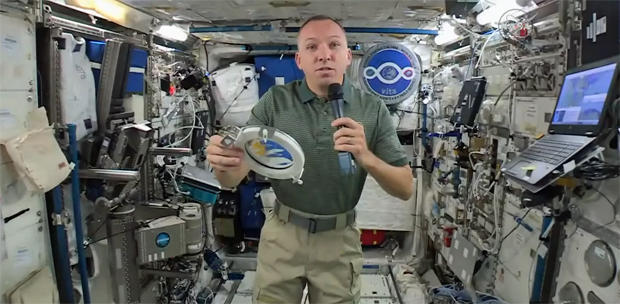
Space station astronaut Randy Bresnik shows off a solar filter that will be used by the crew during multiple opportunities to photograph the Aug. 21 solar eclipse from their perch 250 miles up.
One orbit later, the station will cross the path of the eclipse in the extreme northwest following a trajectory that will carry the lab over central Canada on the way to the North Atlantic. From the station's perspective, 44 percent of the sun will be blocked in a partial eclipse. But the crew will be able to see the umbra, where the eclipse is total, near the southern horizon.
"We'll be north of Lake Huron in Canada when we'll be able to see the umbra, or the shadow of the eclipse, actually on the Earth, right around the Tennessee-Kentucky (area), the western side of both those states," Bresnik said. "That'll be an opportunity for us to take video, and take still pictures and kind of show you from the human perspective what that's going to look like."
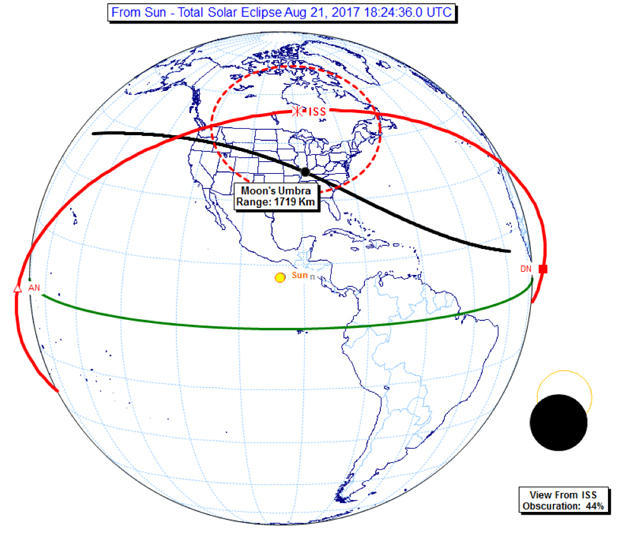
During the second of three successive orbits, the space station crew, passing just south of Hudson Bay, will have a chance to see and photograph the moon's shadow as it moves across western Kentucky and northwestern Tennessee some 1,100 miles away.
The umbra, defining the 70-mile-wide shadow where the sun's disk will be completely blocked out, will be at its closest to the space station at 2:23 p.m. The moon's shadow will be about 1,100 miles away from the lab complex, but from their perch 250 miles up, the astronauts should be able to photograph the dark patch as they race along in their orbit.
"And then the third pass is actually just off the East Coast," Bresnik said. "We'll come around one more time and from the station side we'll see about an 85 percent eclipse of the sun looking up (at 4:17 p.m.). So we should be able to get really neat photos, with our filters, of the sun being occluded by the moon."
NASA plans to provide four hours of eclipse coverage, starting at noon EDT, on the agency's satellite television channel, in web streams and via social media, including Twitter, Instagram and Facebook.
"We have a lot of options to share all this," Bresnik told a Facebook questioner. "It's U.S. taxpayer dollars. ... You're paying us to take these pictures, and they go to you. They're free to everybody, and you can access them from the NASA website."
Quelle: CBS News





